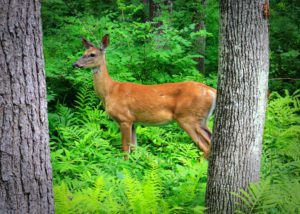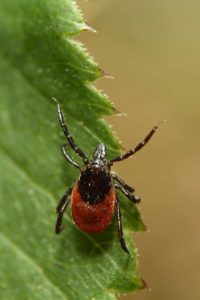“QUESTING” IS A TICK’S VERSION OF HITCHHIKING
By Chris Williams on August 30, 2019.
Each life stage of a hard tick (our blacklegged or deer tick, for example) must have a blood meal in order to molt to the next stage in its life cycle or to lay eggs. Each life stage generally feeds on a different host animal suited to its habitat and size. For example, the very tiniest, newly hatched tick nymphs may feed on mice, lizards, or chipmunks. Larger nymphs may feed on squirrels, rabbits, or birds. And the adult tick may feed on deer, foxes, or perhaps the unlucky hiker. Since the ticks drop off of their current host animal to molt to the next stage, how in the world do they find and then get onto another larger host?
“BE A DEER AND LET ME CLIMB ONBOARD…”
…says the questing tick to any warm body passing by!

Deer along a driveway in NH. Z. Ciras
Ticks find their next host animal using a technique called “questing.” Hungry ticks wait in leaves on the ground for rodents, or climb tall grasses, weeds, or shrubs, and position themselves at about the same height as the larger host animal they are seeking. They wait on the edge of a leaf with front legs outstretched. When a deer or other potential host brushes past, the waiting tick quickly grabs on, climbs aboard, and looks for a good place to insert its mouthparts. Ticks don’t waste their time by questing just anywhere. They improve their results by waiting along wildlife gathering areas or travel routes such as mouse runs or deer trails.
Ticks are most abundant where their host animals are most abundant. Unfortunately for us, wildlife will often travel on people paths in wooded or dense areas. This is why health officials warn hikers to stay in the cleared, vegetation-free center of nature trails and footpaths and to avoid straying off of the path, wading through weeds or grasses, or touching bordering shrubbery. A questing tick will attach to a passing person just as easily.
KEEP QUESTING BEHAVIOR IN MIND WHEN VENTURING OUT
We already know that the incidence of Lyme disease is greatest in areas where homes with large grassy lawns are bordered by woods. This habitat is a typical home for rodents and deer, two of the host animals for the blacklegged tick that transmits Lyme disease. These properties also often have man-made or animal-made trails going from lawn into woods. Tick questing behavior is one reason why we warn that residents are most likely to pick up ticks along the wooded or brushy edges of their yards where suburban lawns meet the Bambi and Thumper zone.
MAKE YOUR YARD A TICK-FREE ZONE
Children should be warned about venturing off of trails and walking through vegetation just beyond their yard’s edge. One good way to reinforce this is to establish a wide mulch border around the perimeter of your yard between the end of the lawn and the beginning of woods or brushy areas. This “tick border” will remind everyone not to venture beyond without tick protection.

Tick questing from a leaf. Shutterstock.
Tick repellent spray with long-sleeves and long pants tucked into socks are your best protection against questing ticks. You may not be able to keep questing ticks from getting onto your clothing, but light colors may allow you to see and remove them. Conduct tick checks on all people and pets who have been in high-risk tick areas and remove attached ticks immediately (see: An Attached Tick! How to Remove it the Right Way)
As tick-transmitted diseases continue to increase, researchers at the Centers for Disease Control (CDC) have come up with relatively simple steps that homeowners can take to establish tick-free zones in their yards (see: Time to Prep Your Yard for Another Tick Season!)